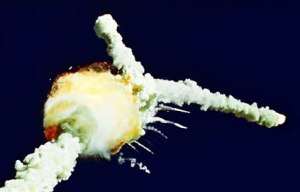 I was in my office that cold morning in 1986, puzzling out a way to print a dictionary using the UNIX Troff program, when my Dutch colleague, Gertjan, entered my office and said, “I think something bad has happened.”
I was in my office that cold morning in 1986, puzzling out a way to print a dictionary using the UNIX Troff program, when my Dutch colleague, Gertjan, entered my office and said, “I think something bad has happened.”
For the rest of the morning we listened to the radio in horrified disbelief as it became clear that the US space shuttle Challenger had exploded shortly after takeoff over Florida, killing its crew of seven, including Christa McAuliffe, the first school teacher to ride the rocket. This would be the worst loss of life in a single mission in NASA’s history.
STS-51-L, as the flight was designated, was the 10th launch for Challenger and would have been NASA’s 25th manned shuttle mission. It had been nearly 5 years since the first manned flight by Columbia, which itself was lost in 2003 when it broke up over Texas on re-entry.
What Challenger revealed was that NASA had become complacent about safety, having been lulled to sleep by so many years of successful missions, and under the enormous pressures of schedule and budget to keep the machines flying. The warnings of NASA engineers about the special risks they were facing on that particular flight were dismissed by NASA management, making the disaster almost inevitable.
Leading up to STS-51-L, engineers had seen troubling evidence that hot gases were leaking past the rubber seals in the mating joints of the solid rocket boosters. STS-51-L was being launched in colder temperatures than NASA had ever experienced on launch day. The engineers were uneasy about the temperatures, but were unable to make a reasoned, effective case for scrubbing the launch. They had concerns, but no hard data. Later, it was determined that the extreme cold had caused the rubber gaskets in the boosters to harden and shrink enough to allow a jet of hot gases to vent out of the side of one of the rockets, where it was aimed like a blowtorch at the main fuel tank. The resulting explosion tore the shuttle apart.
The program was put on hold for two and a half years while NASA fixed known technical problems and redesigned its safety program. The shuttle flights continued on September 29, 1988, but this time with a new found sobriety about the inherent dangers and risks in manned spaceflight.
I’m one of those who thinks that manned spaceflight has been good for the US, having stimulated the development and application of a great many beneficial technologies, and it has been good for the advancement of scientific knowledge. It is a good thing to be curious about the wonders of creation.
We have become more and more risk averse as a society. Life is precious, but living is inherently risky. While we are right to balance risk and safety, our fear of death has driven the scales hard against the safety side of the balance. 25% of the cost of purchasing a ladder is the price of liability protection for the manufacturer against lawsuits. Such liability protection is so expensive that the Cessna and Beech aircraft companies have discontinued most of their small airplanes, even though 85% of all small-plane crashes are attributed to pilot error.
The Challenger accident could have been prevented, but something else would have inevitably failed, and killed. The technological systems we create and depend on daily, from high-rise buildings to high-speed rail to air and automobile transportation to medical advances to the communication and power systems used to display this post on the Internet, all of it is too complex and too fragile to ever be completely dependable, or completely safe.
If NASA had thrown in the towel after Challenger, we would likely never have launched (and thrice-repaired) the Hubble Space Telescope, nor developed the International Space Station, nor gained a host of important insights and advances in our understanding of the universe.
On this day, I want to honor the fallen crews of Apollo 1, Challenger, and Columbia, as well as those hundreds of brave men and women who have risked their lives in manned space flight so that we can better understand the universe and that rare and remarkable spark of God, human life.

